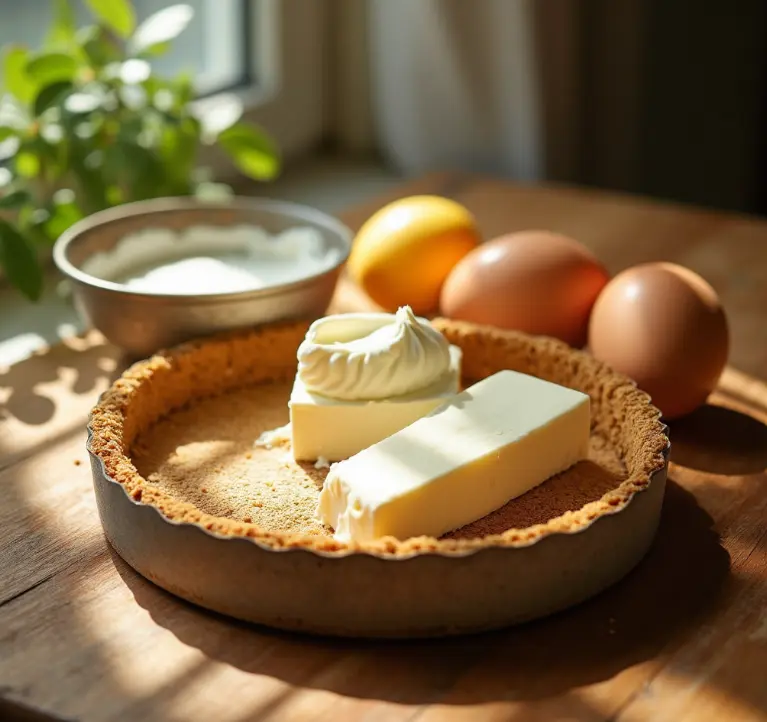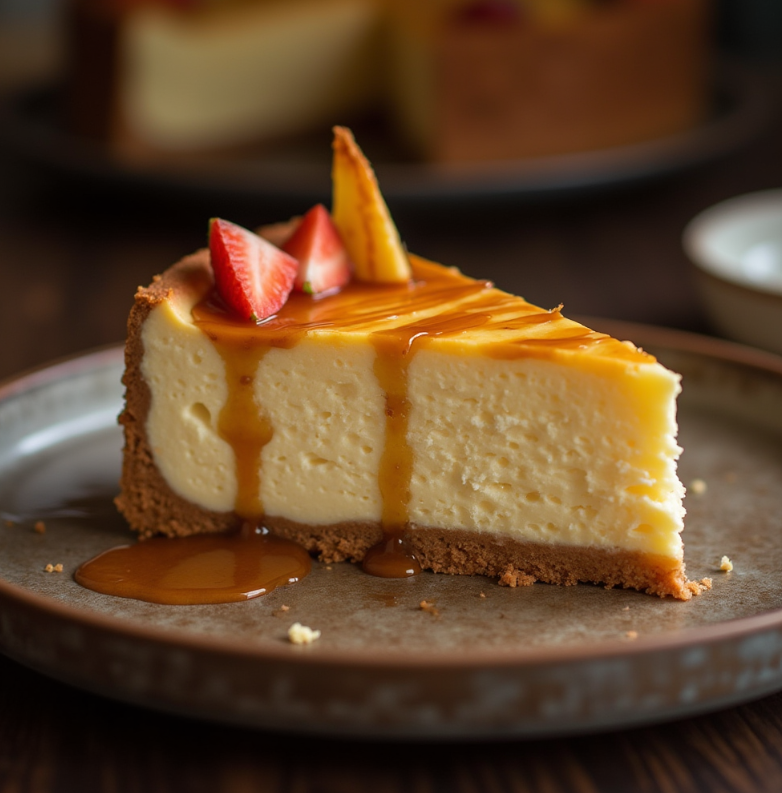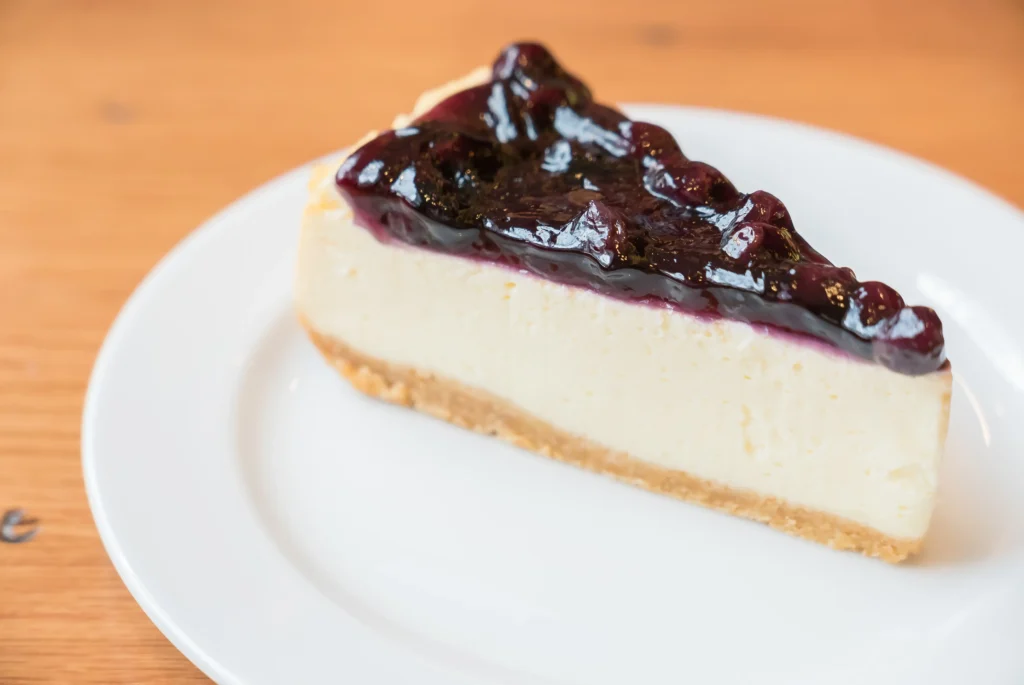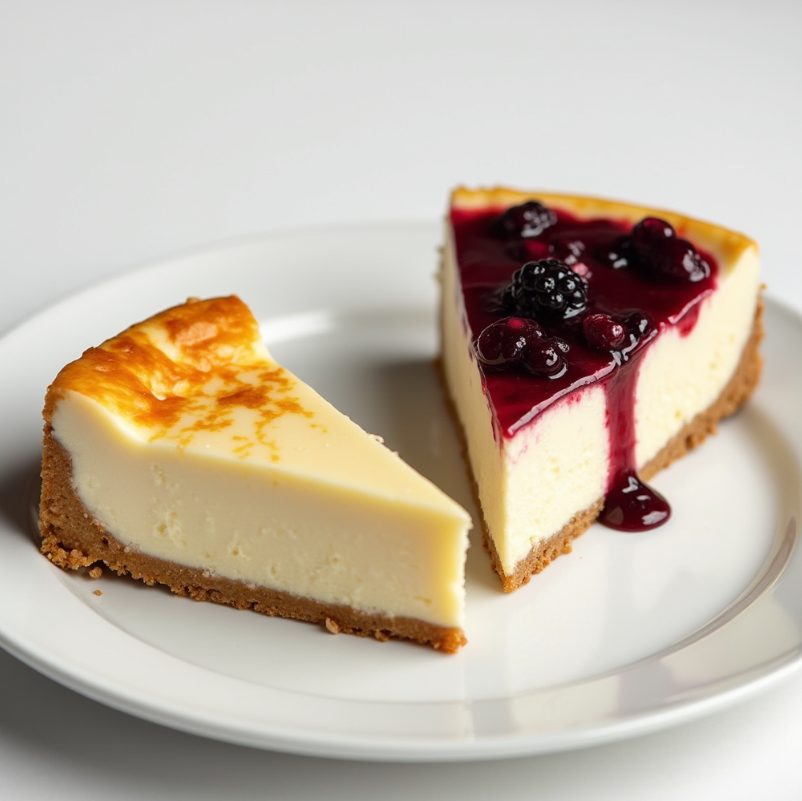Cheesecake is one of the most beloved desserts worldwide, with countless variations catering to diverse palates. Among the many types, New York cheesecake and classic cheesecake are often compared for their distinct characteristics. While both share a common base of cream cheese, eggs, and a graham cracker or pastry crust, subtle differences in ingredients, texture, and preparation methods set them apart.
Understanding the difference between New York Cheesecake and Classic Cheesecake will help you better appreciate the art of cheesecake making and choose the one that suits your taste buds best. Let’s delve deeper into the defining traits of these two iconic desserts.
Table of Contents
Defining Cheesecake
Cheesecake is a versatile dessert that blends creaminess, sweetness, and a touch of tanginess, creating a treat loved across cultures. But what exactly makes a cheesecake, and how has it evolved over time?
What Makes a Dessert a Cheesecake?
At its core, cheesecake is a dessert made from soft cheese, eggs, sugar, and other flavorings, baked or set over a crust. The cheese, usually cream cheese or ricotta, forms the foundation of its texture and flavor. Cheesecake can be categorized into two main types: baked and no-bake, with baked versions being the more traditional approach.
The crust is typically made from crushed graham crackers, digestive biscuits, or short-crust pastry, serving as a buttery base that complements the creamy filling. Despite its name, cheesecake isn’t always cake-like; it’s more of a custard or pie in texture.
A Brief History of Cheesecake
Cheesecake dates back thousands of years, with its origins in ancient Greece. The Greeks served a rudimentary form of cheesecake to athletes during the first Olympic Games in 776 BC. Later, the recipe made its way to Rome and spread throughout Europe during the Middle Ages.
In the 18th century, cheesecake began to resemble its modern form with the introduction of cream cheese, which became a staple ingredient in the United States. Today, variations abound, reflecting local ingredients, cultural preferences, and culinary innovation.
Regional and Cultural Influences
Cheesecake recipes often reflect the culinary traditions of their regions. For instance:
- Italian cheesecake uses ricotta or mascarpone for a lighter texture.
- Japanese cheesecake is airy and soufflé-like, incorporating whipped egg whites.
- American cheesecakes, including the New York variety, are characterized by their rich, dense consistency.
New York and classic cheesecakes both belong to the American tradition but differ significantly in execution and flavor.
What is Classic Cheesecake?

Classic cheesecake represents the traditional version of this dessert, beloved for its balanced flavor and texture. While variations exist worldwide, the term “classic cheesecake” generally refers to a traditional baked cheesecake made with cream cheese, eggs, sugar, and a graham cracker crust. Let’s explore its defining features in detail.
Ingredients in Classic Cheesecake
The ingredients of a classic cheesecake are simple yet effective in achieving its iconic taste and texture:
- Cream Cheese: The main ingredient that provides a creamy base.
- Eggs: Essential for setting the filling during baking.
- Sugar: Adds sweetness to balance the tanginess of the cream cheese.
- Vanilla Extract: Offers subtle aromatic notes.
- Heavy Cream or Sour Cream (Optional): Adds richness and ensures a smoother consistency.
- Graham Cracker Crust: Made from crushed graham crackers, sugar, and melted butter, this forms the dessert’s base.
Texture and Flavor Profile
Classic cheesecake strikes a harmonious balance between richness and lightness. Its texture is smooth and creamy, with just enough firmness to hold its shape when sliced. The flavor is subtly sweet, with a mild tang from the cream cheese, making it versatile for pairing with toppings like fresh fruit, chocolate, or caramel.
Common Variations and Global Styles
Classic cheesecake has inspired many regional adaptations, each with its unique twist:
- Philadelphia-Style Cheesecake: Often conflated with classic cheesecake, it excludes heavy cream or sour cream, resulting in a slightly firmer texture.
- Italian Cheesecake: Replaces cream cheese with ricotta or mascarpone for a lighter texture and less tangy flavor.
- French Cheesecake: Uses Neufchâtel cheese and often incorporates gelatin for a silkier, mousse-like texture.
Despite these variations, the hallmark of a classic cheesecake remains its simplicity and adaptability, offering a blank canvas for a wide range of flavors and toppings.
What is New York Cheesecake?

New York cheesecake is often regarded as the gold standard among cheesecakes, known for its luxurious texture and indulgent flavor. This style of cheesecake emerged as a distinct variation in the early 20th century, gaining popularity for its no-compromise richness and dense, creamy consistency. But what sets New York cheesecake apart from the classic version? Let’s take a closer look.
Defining Characteristics of New York Cheesecake
The defining traits of New York cheesecake go beyond its ingredients. It’s a dessert designed to showcase decadence:
- Richness: Known for its incredible density and creaminess, New York cheesecake is heavier than most other styles. It aims to provide a luxurious mouthfeel in every bite.
- Simplicity in Toppings: Unlike other variations, which may rely on fruit or elaborate garnishes, New York cheesecake often stands alone. A light dusting of powdered sugar or a dollop of sour cream might be the only accompaniment.
- Signature Height: New York cheesecakes are often taller than their counterparts due to the generous amount of batter used and the use of springform pans.
Key Ingredients and Their Importance
What makes New York cheesecake unique is its reliance on specific ingredients, which are carefully balanced to achieve its distinct taste and texture.
- Cream Cheese: The foundation of New York cheesecake, cream cheese is used in abundance. The higher quantity amplifies its creamy richness.
- Sour Cream: This ingredient is crucial in New York cheesecake. It adds tanginess and ensures the cheesecake stays moist and smooth, even after baking.
- Eggs and Egg Yolks: While classic cheesecake uses whole eggs, New York cheesecake incorporates additional egg yolks. This contributes to the custard-like texture.
- Sugar: Adds the necessary sweetness to balance the tangy cream cheese and sour cream.
- Vanilla Extract: A subtle yet essential flavoring agent.
- Heavy Cream (Optional): Some recipes include heavy cream for added richness and silkiness.
Even the crust is often slightly different. While New York cheesecake can feature a traditional graham cracker crust, some versions use a pastry crust, enhancing the dessert’s overall indulgence.
The Signature Taste and Texture
The hallmark of a New York cheesecake is its dense yet velvety texture. Unlike the lighter and airier classic cheesecake, New York cheesecake feels substantial and creamy, almost like a custard. This consistency is achieved by carefully blending the batter to eliminate air bubbles and baking the cheesecake at a low, steady temperature.
Flavor-wise, New York cheesecake is tangier and more pronounced in its cream cheese flavor compared to the subtler classic version. The sour cream adds depth, and the dessert has a richness that lingers on the palate.
A Historical Perspective on New York Cheesecake
The origins of New York cheesecake can be traced back to the 1920s when Arnold Reuben, a restaurateur, is credited with creating this decadent version. Inspired by European cheesecakes but seeking something richer, Reuben introduced the now-famous recipe in his New York City restaurants.
Its association with New York also ties to the abundance of cream cheese, a product developed by dairies in the northeastern United States. Over time, the recipe became a signature dessert of the city, gracing menus from high-end eateries to classic diners.
Modern Variations of New York Cheesecake
While purists argue that New York cheesecake should remain unadorned, modern versions sometimes incorporate additional flavors. Popular variations include:
- Chocolate New York Cheesecake: Swirled or layered with chocolate for added decadence.
- Marble Cheesecake: Featuring ribbons of chocolate or fruit puree throughout the batter.
- Seasonal Flavors: Pumpkin spice, gingerbread, or berry infusions tailored to different times of the year.
Despite these innovations, the essence of New York cheesecake remains unchanged: rich, creamy, and unmistakably indulgent.
Key Differences Between New York Cheesecake and Classic Cheesecake
New York cheesecake and classic cheesecake may seem similar at first glance, but their differences run deep, from the ingredients and baking methods to their textures and flavor profiles. Understanding these differences not only highlights the artistry behind each style but also helps cheesecake enthusiasts choose the version that best suits their taste buds.
Ingredients – A Delicate Balancing Act
The ingredients used in New York and classic cheesecakes overlap but vary significantly in their proportions and additional elements.
- Cream Cheese:
- Both versions rely on cream cheese as the main ingredient, but New York cheesecake uses it in greater quantities. This gives the dessert its signature density and richness.
- Classic cheesecake incorporates cream cheese as well but balances it with other ingredients for a lighter texture.
- Sour Cream:
- Sour cream is a hallmark of New York cheesecake, lending tanginess and ensuring a creamy consistency.
- In classic cheesecake, sour cream is often optional and used sparingly, resulting in a slightly milder tang.
- Egg Yolks:
- New York cheesecake recipes frequently include extra egg yolks. This addition enhances the custard-like texture, making it smoother and denser.
- Classic cheesecake typically uses whole eggs without additional yolks, contributing to its lighter texture.
- Heavy Cream:
- New York cheesecake occasionally incorporates heavy cream for an ultra-rich flavor.
- Classic cheesecake usually omits heavy cream, focusing on simpler, lighter components.
- Crust:
- New York cheesecake sometimes features a pastry crust instead of the more common graham cracker crust, reinforcing its decadence.
- Classic cheesecake almost always uses a graham cracker crust, which is buttery and crisp, complementing the filling without overwhelming it.
Texture – Dense vs. Light
The textures of New York and classic cheesecakes are among their most defining differences.
- New York Cheesecake:
- Dense and velvety, New York cheesecake feels heavy and substantial. Every bite is creamy and rich, providing a luxurious mouthfeel.
- Its smoothness comes from a careful mixing process that minimizes air incorporation, creating a solid yet creamy texture.
- Classic Cheesecake:
- Classic cheesecake is lighter, creamier, and more mousse-like in texture. It strikes a balance between firmness and fluffiness, making it easier to eat in larger portions.
- The texture is less intense, catering to those who prefer a less rich dessert experience.
Baking Techniques and Methods
The baking process also plays a key role in distinguishing New York and classic cheesecakes.
- New York Cheesecake:
- New York cheesecake is baked at a high temperature initially to help the batter set quickly and avoid sinking. The temperature is then reduced for a long, slow bake to ensure the interior cooks evenly without drying out.
- Many recipes call for a water bath (bain-marie) to maintain moisture and prevent cracks. However, some bakers skip this step, relying on the dense batter to hold its shape.
- Classic Cheesecake:
- Classic cheesecake is typically baked at a lower temperature throughout, resulting in a softer texture.
- Water baths are less common but can be used to avoid cracks and achieve an even bake.
- Resting and Cooling:
- Both cheesecakes require proper cooling to prevent cracks and maintain their texture. However, New York cheesecake often benefits from an overnight rest in the refrigerator to develop its flavors fully.
Flavor Profiles – Bold vs. Subtle

New York cheesecake and classic cheesecake differ in their flavor intensities.
- New York Cheesecake:
- Bold and tangy, New York cheesecake emphasizes the cream cheese’s natural flavor, with the sour cream adding complexity.
- Its richness makes it a standalone dessert that doesn’t rely on heavy toppings or accompaniments.
- Classic Cheesecake:
- Subtle and versatile, classic cheesecake has a more neutral sweetness. This makes it ideal for pairing with fruit compotes, chocolate, or other creative toppings.
- The milder flavor allows the crust and additional flavors to shine without overpowering the dessert.
Serving Styles and Occasions
New York and classic cheesecakes cater to different dining experiences and occasions.
- New York Cheesecake:
- Often served plain or with minimal toppings to highlight its rich, tangy flavor. A drizzle of berry sauce or a dollop of whipped cream might be the only addition.
- It’s commonly associated with indulgent occasions or upscale dining experiences.
- Classic Cheesecake:
- Frequently served with a variety of toppings, such as fresh fruit, chocolate shavings, or caramel drizzle, to enhance its lighter flavor.
- This style is more adaptable for casual gatherings, as its balanced sweetness appeals to a wider audience.
FAQs
Cheesecake enthusiasts often have questions about the distinctions between New York and classic cheesecakes. Here are answers to some of the most commonly asked questions to help clarify their differences and unique qualities.
Why is New York cheesecake denser?
New York cheesecake is denser because of its ingredient ratios and preparation method. The high proportion of cream cheese, additional egg yolks, and sometimes heavy cream contribute to its rich, dense texture. Furthermore, the batter is mixed carefully to minimize air incorporation, ensuring a smooth and compact consistency.
Can you make a classic cheesecake with New York techniques?
Yes, but the result will blend characteristics of both styles. Using New York techniques, such as adding sour cream or baking at high and then reduced temperatures, will make the classic cheesecake slightly denser and richer. However, without the larger quantities of cream cheese and additional egg yolks, it won’t fully replicate the New York cheesecake’s signature texture.
Which cheesecake is easier to bake at home?
Classic cheesecake is generally easier for beginners because its lighter texture is more forgiving, and the baking method is straightforward. New York cheesecake, on the other hand, requires precise temperature control and often involves a water bath to avoid cracks and ensure even baking. It’s worth the extra effort, though, for its luxurious outcome.
What makes New York cheesecake unique in taste?
New York cheesecake’s uniqueness comes from its tangy and bold flavor. The combination of cream cheese, sour cream, and sometimes heavy cream creates a taste that is rich, slightly tangy, and deeply satisfying. Its minimal reliance on toppings allows the core ingredients to shine, making it a pure expression of cheesecake indulgence.
Can a cheesecake be neither New York nor classic?
Absolutely! Cheesecake is a versatile dessert with countless variations. Japanese cheesecake, for instance, is light and fluffy, resembling a soufflé. Italian cheesecake uses ricotta or mascarpone for a lighter, less tangy flavor. There are also hybrid cheesecakes that borrow elements from different styles, creating unique textures and flavors.
What’s the best topping for each cheesecake style?
- New York Cheesecake: This style is often served plain or with simple toppings like a thin layer of sour cream, fresh berries, or a light drizzle of fruit sauce. The goal is to complement its rich flavor without overshadowing it.
- Classic Cheesecake: The versatility of classic cheesecake makes it ideal for pairing with a variety of toppings, such as chocolate ganache, caramel, mixed berries, or even a dusting of powdered sugar.
Conclusion
Cheesecake is a timeless dessert that has captured the hearts and taste buds of dessert lovers worldwide. Within this expansive category, New York cheesecake and classic cheesecake stand out as two of the most beloved and iconic variations. While they share a common foundation of cream cheese, eggs, and a delicious crust, their differences reflect the diversity and creativity inherent in cheesecake-making.
Recap of the Distinctions
- New York Cheesecake is the embodiment of indulgence. Its dense, creamy texture and bold tanginess make it a luxurious choice for those who crave richness in every bite. The inclusion of sour cream and egg yolks, combined with its unique baking technique, results in a dessert that’s heavy, satisfying, and often served with minimal adornment to let its flavors shine.
- Classic Cheesecake, on the other hand, is versatile and universally appealing. Its lighter texture and milder flavor make it a canvas for creativity, pairing beautifully with a range of toppings from fruit compotes to decadent sauces. The simplicity of its preparation and ingredients gives it a comforting, nostalgic quality.
Choosing the Right Cheesecake for Your Preference
When deciding between New York and classic cheesecake, it ultimately comes down to personal taste and the occasion:
- Choose New York cheesecake if you prefer a bold, creamy, and tangy dessert that can stand alone as a showstopper.
- Opt for classic cheesecake if you enjoy a balanced, lighter option that can be tailored with your favorite toppings and flavors.
Consider the setting as well. For formal dinners or special celebrations, the rich decadence of New York cheesecake might be the perfect centerpiece. For casual gatherings or dessert bars, the approachable flavor and versatility of classic cheesecake may better suit the occasion.
Appreciating Cheesecake as an Art Form
Both New York and classic cheesecakes showcase the artistry of dessert-making. Each represents a unique approach to achieving the perfect blend of sweetness, creaminess, and texture. Understanding their differences not only enhances our appreciation of these desserts but also opens the door to experimenting with various styles and techniques in the kitchen.
Final Thoughts
Whether you’re a cheesecake purist or an adventurous foodie, there’s a cheesecake out there for everyone. New York and classic cheesecakes are not competitors but rather two sides of the same delicious coin. Their unique qualities ensure that cheesecake lovers can always find a version that suits their mood, taste, and occasion.
So the next time you’re faced with the choice between New York and classic cheesecake, why not try both? After all, dessert is about indulgence, and there’s no reason to limit yourself when the options are this delectable.
Here are some suggested internal links for this article, using rich anchor text:
- In the section on baking techniques, you can link to Embark on a Flavorful Adventure with Grandma Rosie as an example of how baking adventures can lead to new discoveries.
- The discussion about cheesecake crusts can link to Discover the Joy of Cooking with Grandma Rosie to provide readers with insights into making versatile crusts for desserts.
- For readers interested in other cheesecake variations, you can link to Blueberry Cheesecake: A Delicious Treat and How to Perfect It to showcase another rich cheesecake recipe.

